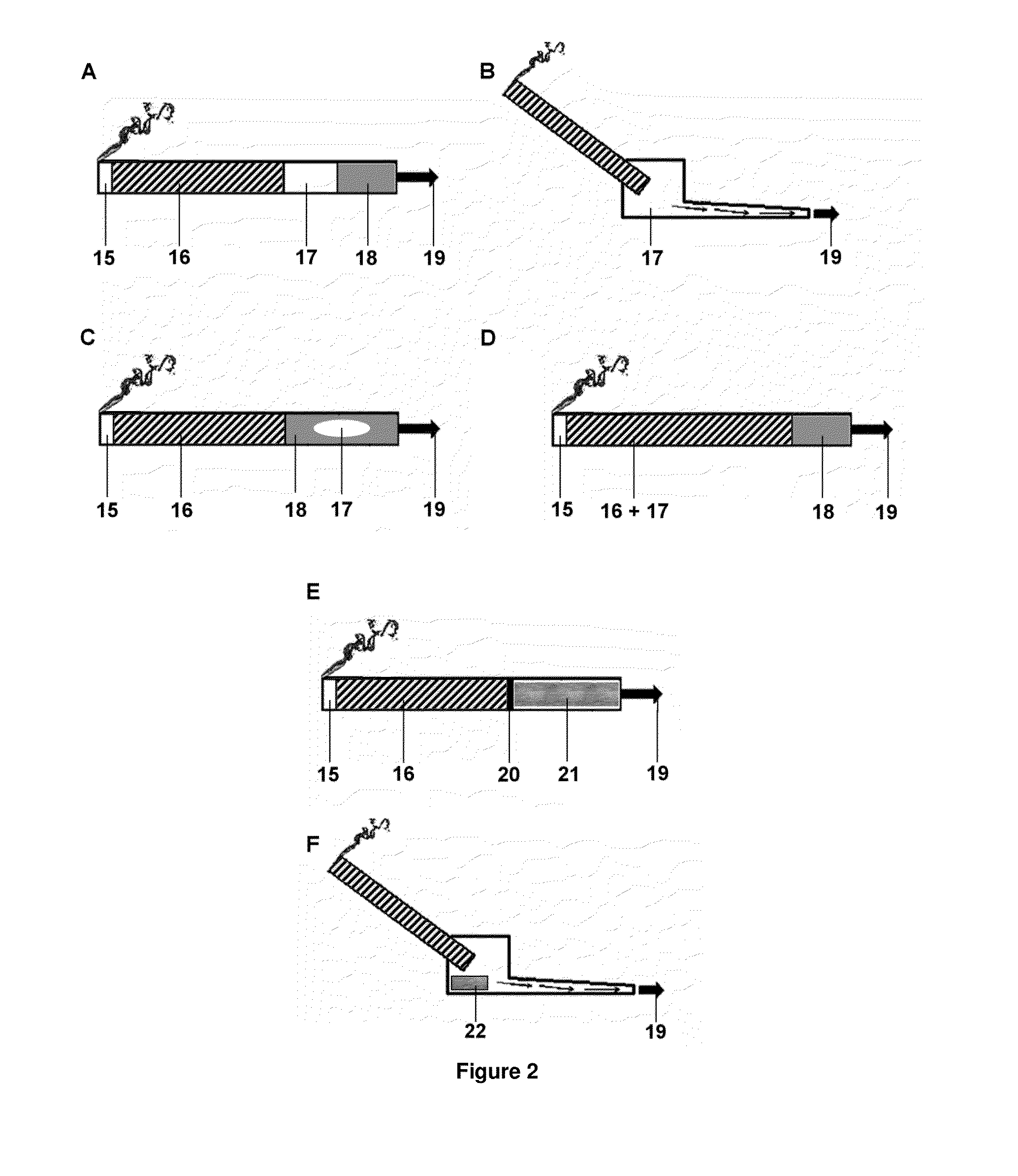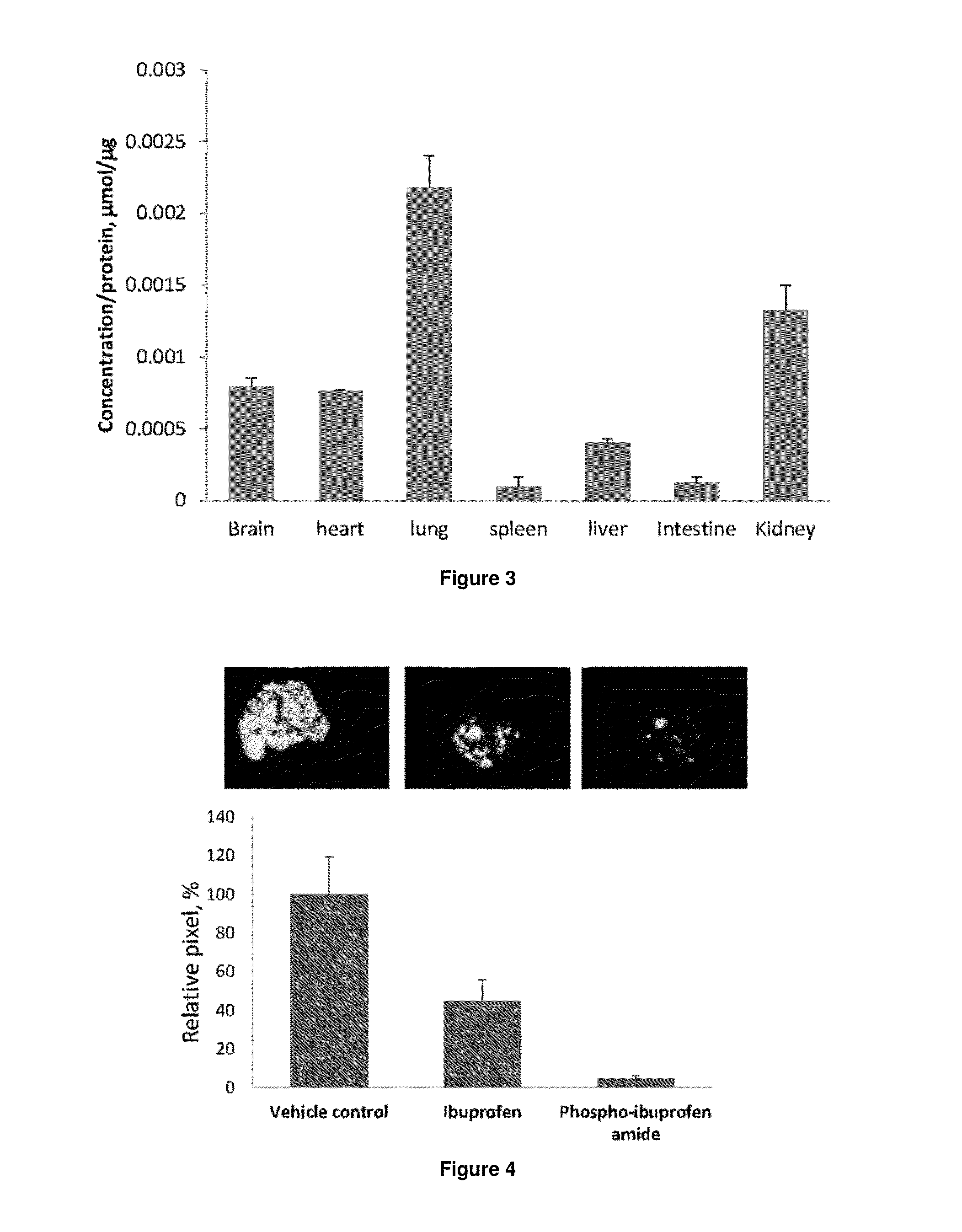Phospho-ester derivatives and uses thereof
a technology of phosphoester and derivatives, applied in the field of phosphoester derivatives, can solve the problems of difficult isolation and treatment, poor survival of lung cancer patients, and cancer mortality in the industrial world, and achieve the effect of reducing the levels of inflammatory cytokines
- Summary
- Abstract
- Description
- Claims
- Application Information
AI Technical Summary
Benefits of technology
Problems solved by technology
Method used
Image
Examples
example 1
Phosphoric acid diethyl ester 4-[2-(4-isobutyl-phenyl)-propionylamino]-butyl ester (phospho-ibuprofen amide, 105)
[0498]The title compound 105 was synthesized as shown in Scheme 1 below.
Step 1.1 Synthesis of N-(4-Hydroxy-butyl)-2-(4-isobutyl-phenyl)-propionamide (136)
[0499]Ibuprofen (135) (0.228 g, 1 mmol), 4-amino-1-butanol (0.138 ml, 1.5 mmol) and O-(Benzotriazol-1-yl)-N,N,N′,N′-tetramethyluronium hexafluorophosphate (HBTU) (0.57 g, 1.5 mmol) were dissolved in 5 ml of N,N-dimethylformamide (DMF) containing N,N-diisopropylethylamine (DIPEA) (0.17 ml, 1 mmol). The reaction mixture was stirred at room temperature for 4 h. The reaction was monitored by TLC. The resulting reaction mixture was dissolved in ethyl acetate, and then washed with 1M HCl, saturated aqueous NaHCO3 solution, distilled water, brine and dried over sodium sulfate (Na2SO4). After the solvent was removed, the crude product was purified by flash column chromatography to give 136 as a white solid in 95% yield.
Step 1.2...
example 2
Cellular Uptake of Ibuprofen, Phospho-Ibuprofen 132 and Phospho-Ibuprofen 137
Test Compounds
[0506]Phospho-ibuprofen derivatives 132 and 137 as shown below and ibuprofen.
Methods
[0507]A431 cells were seeded into 6-well culture plates (5×105 per well). After overnight incubation, the cells were incubated with 100 μM ibuprofen, PI-phosphate 137 and PI-diethylphosphate 132 for 1 h. The media were removed and the monolayers were washed three times with PBS (1% BSA). Finally, the cells were collected in 200 μl PBS, after which 600 μl of acetonitrile was added to extract intracellular drugs. The intracellular levels were determined by HPLC analysis. The compounds evaluated have equivalent molar absorptivity.
Results
[0508]To evaluate the relative cellular uptake of ibuprofen, PI-phosphate 137 and PI-diethylphosphate 132, we incubated these compounds (100 μM for 1 h) with A431 skin cancer cells, and measured their cellular content by HPLC. As shown in FIG. 18, we did not detect significant accu...
example 3
Phosphoric acid diethyl ester 4-{2-[6-fluoro-3-(4-methanesulfinyl-benzylidene)-2-methyl-3H-inden-1-yl]-acetylamino}-butyl ester (phosphosulindac amide, 106)
[0512]Phosphosulindac amide 106 was synthesized according to procedure shown in Scheme 2 below:
Step 3.1 Synthesis of 2-[6-fluoro-3-(4-methanesulfinyl-benzylidene)-2-methyl-3H-inden-1-yl]-N-(4-hydroxy-butyl)-acetamide (139)
[0513]Sulindac (138) (0.356 g, 1 mmol), 4-amino-1-butanol (0.138 ml, 1.5 mmol) and HBTU (0.57 g, 1.5 mmol) were dissolved in 5 ml of DMF further containing DIPEA (0.17 ml, 1 mmol). The reaction mixture was stirred at room temperature for 4 h. The reaction was monitored by TLC. The remnant was dissolved in ethyl acetate, and then washed with 1 M HCl, saturated NaHCO3 solution, distilled water, brine, and dried over Na2SO4. After the solvent was removed under reduced pressure, the crude product was purified by flash column chromatography to give 139 as a white solid in 95% yield.
Step 3.2 Synthesis of phosphoric a...
PUM
| Property | Measurement | Unit |
|---|---|---|
| flash points | aaaaa | aaaaa |
| flash points | aaaaa | aaaaa |
| melting points | aaaaa | aaaaa |
Abstract
Description
Claims
Application Information
 Login to View More
Login to View More - R&D
- Intellectual Property
- Life Sciences
- Materials
- Tech Scout
- Unparalleled Data Quality
- Higher Quality Content
- 60% Fewer Hallucinations
Browse by: Latest US Patents, China's latest patents, Technical Efficacy Thesaurus, Application Domain, Technology Topic, Popular Technical Reports.
© 2025 PatSnap. All rights reserved.Legal|Privacy policy|Modern Slavery Act Transparency Statement|Sitemap|About US| Contact US: help@patsnap.com



